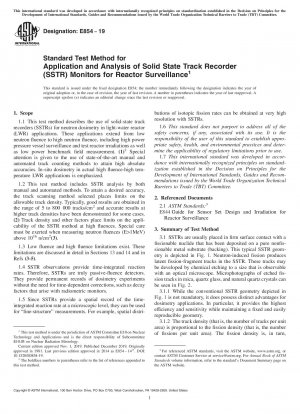ASTM E854-19
Standard Test Method for Application and Analysis of Solid State Track Recorder (SSTR) Monitors for Reactor Surveillance
- Standard No.
- ASTM E854-19
- Release Date
- 2019
- Published By
- American Society for Testing and Materials (ASTM)
- Latest
- ASTM E854-19
- Scope
- 1.1 This test method describes the use of solid-state track recorders (SSTRs) for neutron dosimetry in light-water reactor (LWR) applications. These applications extend from low neutron fluence to high neutron fluence, including high power pressure vessel surveillance and test reactor irradiations as well as low power benchmark field measurement. (1)2 Special attention is given to the use of state-of-the-art manual and automated track counting methods to attain high absolute accuracies. In-situ dosimetry in actual high fluence-high temperature LWR applications is emphasized. 1.2 This test method includes SSTR analysis by both manual and automated methods. To attain a desired accuracy, the track scanning method selected places limits on the allowable track density. Typically, good results are obtained in the range of 5 to 800 000 tracks/cm2 and accurate results at higher track densities have been demonstrated for some cases. (2) Track density and other factors place limits on the applicability of the SSTR method at high fluences. Special care must be exerted when measuring neutron fluences (E>1MeV) above 1016 n/cm2 (3). 1.3 Low fluence and high fluence limitations exist. These limitations are discussed in detail in Sections 13 and 14 and in Refs (3-5). 1.4 SSTR observations provide time-integrated reaction rates. Therefore, SSTRs are truly passive-fluence detectors. They provide permanent records of dosimetry experiments without the need for time-dependent corrections, such as decay factors that arise with radiometric monitors. 1.5 Since SSTRs provide a spatial record of the timeintegrated reaction rate at a microscopic level, they can be used for “fine-structure” measurements. For example, spatial distributions of isotopic fission rates can be obtained at very high resolution with SSTRs. 1.6 This standard does not purport to address all of the safety concerns, if any, associated with its use. It is the responsibility of the user of this standard to establish appropriate safety, health, and environmental practices and determine the applicability of regulatory limitations prior to use. 1.7 This international standard was developed in accordance with internationally recognized principles on standardization established in the Decision on Principles for the Development of International Standards, Guides and Recommendations issued by the World Trade Organization Technical Barriers to Trade (TBT) Committee.
ASTM E854-19 Referenced Document
- ASTM E844 Standard Guide for Sensor Set Design and Irradiation for Reactor Surveillance, E 706(IIC)
ASTM E854-19 history
- 2019 ASTM E854-19 Standard Test Method for Application and Analysis of Solid State Track Recorder (SSTR) Monitors for Reactor Surveillance
- 2014 ASTM E854-14e1 Standard Test Method for Application and Analysis of Solid State Track Recorder (SSTR) Monitors for Reactor Surveillance
- 2014 ASTM E854-14 Standard Test Method for Application and Analysis of Solid State Track Recorder (SSTR) Monitors for Reactor Surveillance, E706(IIIB)
- 2003 ASTM E854-03(2009) Standard Test Method for Application and Analysis of Solid State Track Recorder (SSTR) Monitors for Reactor Surveillance, E706(IIIB)
- 2003 ASTM E854-03 Standard Test Method for Application and Analysis of Solid State Track Recorder (SSTR) Monitors for Reactor Surveillance, E706(IIIB)
- 1998 ASTM E854-98 Standard Test Method for Application and Analysis of Solid State Track Recorder (SSTR) Monitors for Reactor Surveillance, E706(IIIB)
